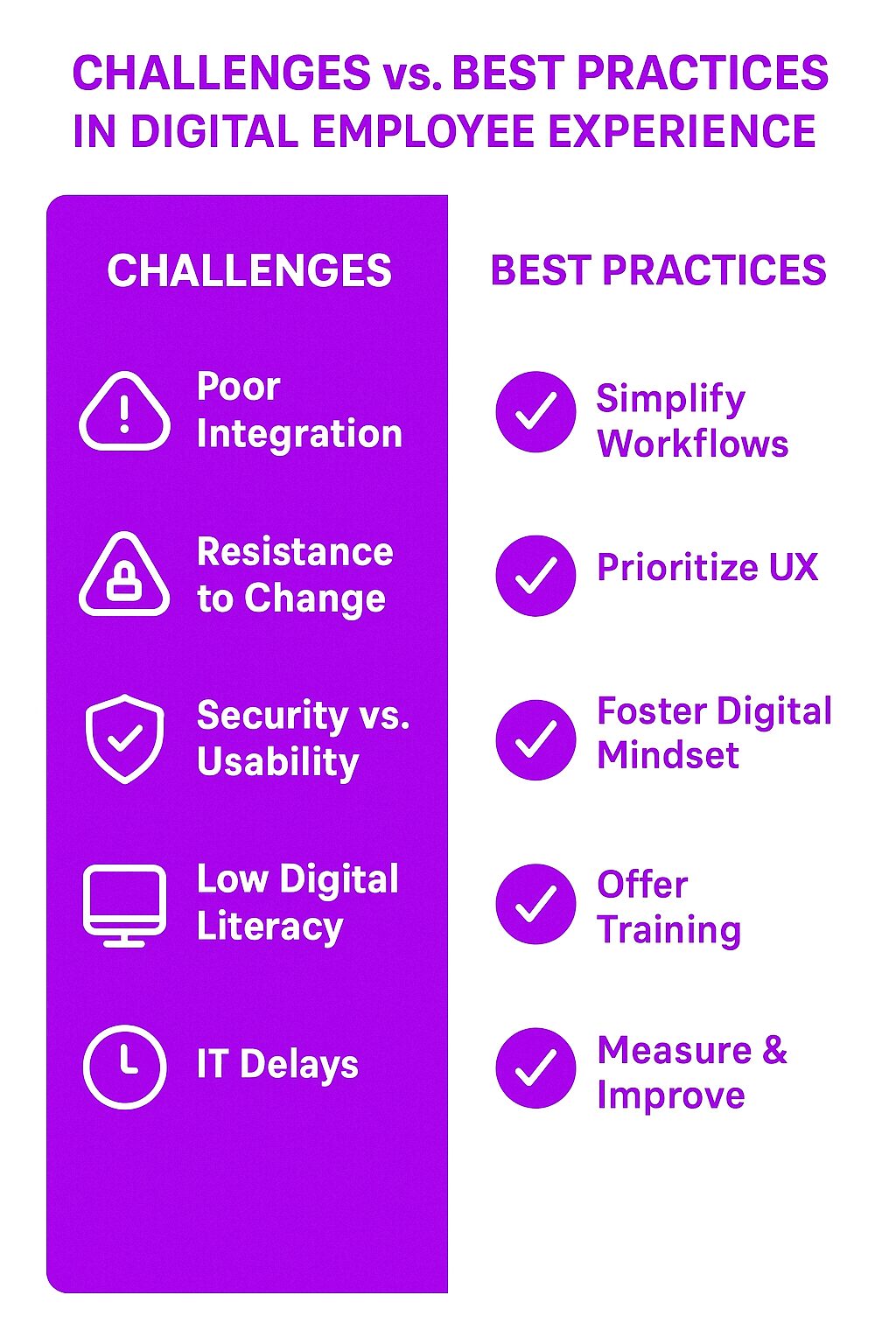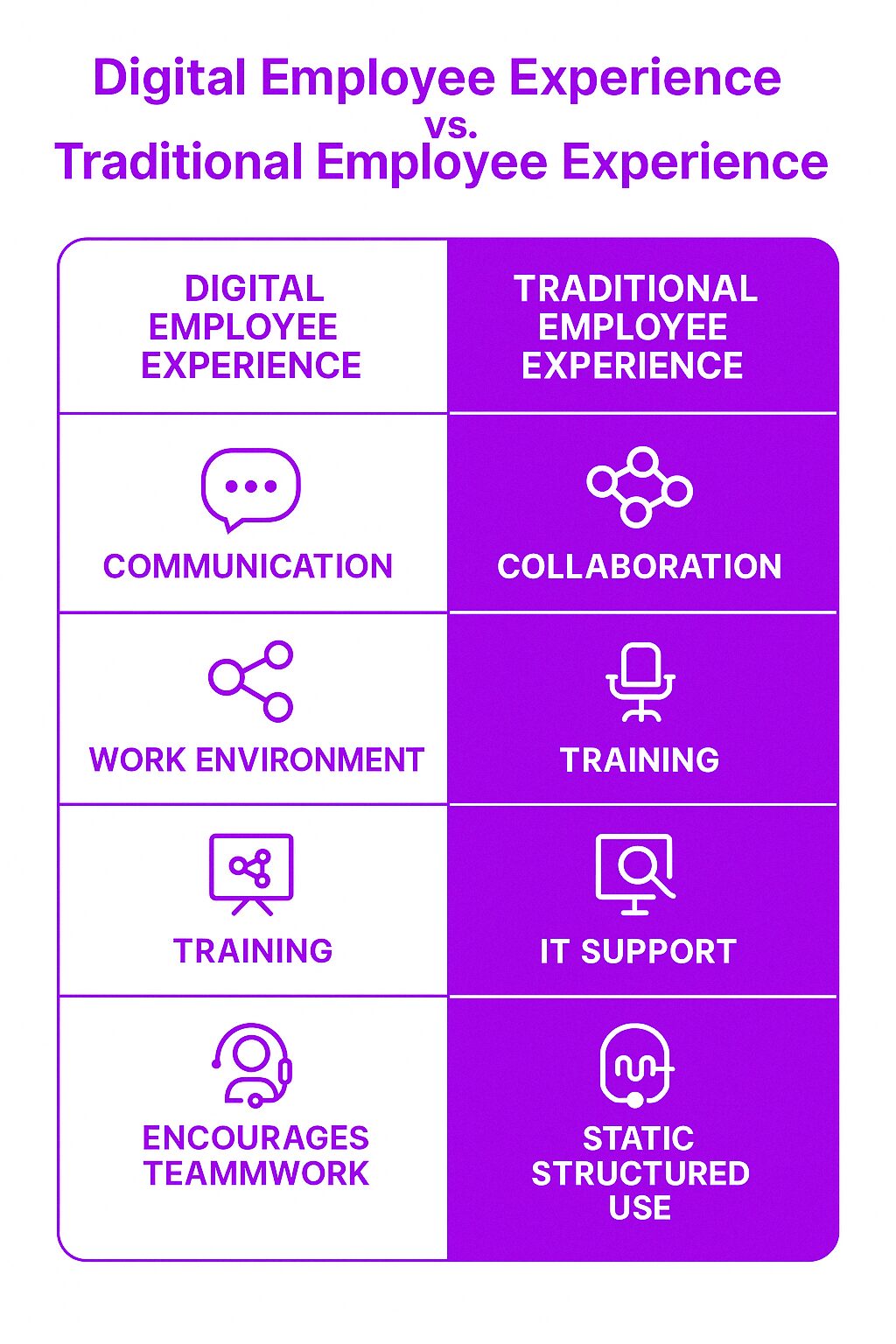What Is Digital Employee Experience?
Digital Employee Experience (DEX) is the sum of all interactions an employee has with workplace technology. It covers everything from the usability of software tools to the efficiency of IT support systems and the effectiveness of communication platforms. A strong DEX ensures that employees can seamlessly perform their tasks without frustration, delays, or inefficiencies caused by digital tools.
Organizations invest in DEX to improve employee satisfaction, increase productivity, and enhance collaboration. A poor digital experience leads to disengagement, lost time, and decreased performance. Companies that prioritize DEX create a workplace where employees can focus on meaningful work rather than battling with inefficient systems.
Digital Workplace and Digital Employee Experience
The digital workplace and digital employee experience are closely intertwined concepts that are essential for modern organizations. The digital workplace refers to the virtual environment where employees work, collaborate, and interact with digital tools and technologies. The digital employee experience, on the other hand, encompasses the perceptions and feelings that employees have about their interactions with digital tools and technologies in the workplace.
A great digital employee experience is critical for employee satisfaction, productivity, and retention. When employees have a positive experience with digital tools and technologies, they are more likely to be engaged, motivated, and productive. On the other hand, a poor digital employee experience can lead to frustration, dissatisfaction, and decreased productivity.
Organizations can improve the digital employee experience by implementing a digital workplace strategy that includes digital tools, employee experience, and employee satisfaction. This strategy should focus on providing employees with the right digital tools and technologies to perform their jobs effectively, as well as ensuring that these tools are user-friendly, accessible, and integrated with other systems.
Objectives of Digital Employee Experience
The primary objectives of digital employee experience are to improve employee satisfaction, productivity, and retention. A great digital employee experience can lead to numerous benefits, including:
-
Increased employee engagement and motivation
-
Improved productivity and efficiency
-
Enhanced employee satisfaction and retention
-
Better business outcomes and revenue growth
-
Improved customer satisfaction and loyalty
To achieve these objectives, organizations should focus on providing employees with a seamless digital employee experience that is personalized, intuitive, and empowering. This can be achieved by implementing digital tools and technologies that are designed to meet the needs of employees, as well as providing ongoing training and support to ensure that employees are able to use these tools effectively.
The Role of DEX in Modern Workplaces
As businesses adopt hybrid and remote work models, the importance of digital experiences grows. Digital employee experience management (DEX) plays a crucial role in optimizing and monitoring employee interactions with technology in the workplace. Employees expect seamless access to tools, reliable communication channels, and intuitive workflows. When digital systems fail, productivity suffers, and frustration rises. DEX addresses these challenges by ensuring that employees have the right tools, training, and support.
A strong digital experience is not just about having the latest technology; it’s about how well employees can use it. Businesses that implement DEX strategies create an environment where employees feel empowered, engaged, and connected to their work.
Key Components of Digital Employee Experience
1. User Interface and Experience (UI/UX)
A well-designed user interface ensures employees can navigate digital technologies without confusion. Clunky, outdated software frustrates employees and slows productivity. Modern workplaces prioritize user-friendly platforms that integrate seamlessly across devices.
2. Accessibility and Mobility
Employees need access to digital tools from anywhere. Cloud-based systems and mobile-friendly applications support hybrid and remote workforces. Ensuring accessibility across different devices improves flexibility and efficiency.
3. Integration of Digital Tools
Digital technology plays a crucial role in the modern workplace. Disconnected tools lead to inefficiencies. Integrated platforms enable smooth transitions between communication apps, project management software, and collaboration tools. A well-connected digital ecosystem reduces frustration and increases productivity.
4. Communication and Collaboration Platforms
Reliable messaging apps, video conferencing tools, and digital workspaces help teams stay connected. Businesses that invest in high-quality communication platforms ensure employees can collaborate effectively, regardless of location.
5. IT Support and Troubleshooting
Technical issues disrupt workflow. Organizations can manage digital employee experience effectively by taking a proactive approach that prevents issues before they arise. A responsive IT support system reduces downtime and frustration. Self-service portals, AI-driven chatbots, and quick-response IT teams improve the digital employee experience.
6. Digital Training and Onboarding
Employees must know how to use digital tools effectively. Comprehensive training programs and ongoing learning opportunities ensure employees stay confident and competent in their digital environment.
7. Feedback and Continuous Improvement
Organizations that listen to employee feedback about digital tools can refine their systems. A digital employee experience solution (DEX) is essential for addressing feedback and fostering continuous improvement. Regular surveys and digital experience analytics help businesses identify pain points and make improvements.
Creating a Digital Employee Experience Strategy
Creating a digital employee experience strategy requires a comprehensive approach that involves multiple stakeholders and departments. The following steps can help organizations create a digital employee experience strategy:
-
Define the objectives and goals of the digital employee experience strategy.
-
Conduct employee research and feedback to understand their needs and pain points.
-
Identify the digital tools and technologies that are required to meet employee needs.
-
Develop a roadmap for implementing the digital employee experience strategy.
-
Establish metrics and benchmarks to measure the success of the strategy.
-
Provide ongoing training and support to ensure that employees are able to use digital tools and technologies effectively.
A digital employee experience strategy should be aligned with the organization’s overall business strategy and goals. It should also be flexible and adaptable to changing employee needs and technological advancements.
Measuring Digital Employee Experience
Measuring digital employee experience is critical to understanding its impact on employee satisfaction, productivity, and retention. The following metrics can be used to measure digital employee experience:
-
Employee satisfaction and engagement surveys
-
Net promoter score (NPS) and employee net promoter score (ENPS)
-
Digital tool adoption and usage rates
-
Employee productivity and efficiency metrics
-
Customer satisfaction and loyalty metrics
Organizations can use these metrics to identify areas for improvement and to measure the success of their digital employee experience strategy. Regular feedback and surveys can also help organizations to understand employee needs and pain points, and to make data-driven decisions to improve the digital employee experience.
By measuring digital employee experience, organizations can ensure that their digital workplace strategy is aligned with employee needs and is delivering the desired business outcomes.
Why Digital Employee Experience Matters
1. Boosts Employee Engagement
Empowering employees through a positive digital experience leads to higher engagement levels. Employees who can seamlessly perform their work without digital barriers feel more valued and motivated.
2. Increases Productivity
When employees have access to intuitive tools and reliable systems that empower employees, they complete tasks faster. A strong DEX eliminates unnecessary delays and inefficiencies.
3. Reduces Employee Burnout
Frustration with poor digital systems leads to stress and burnout. A well-designed digital experience minimizes technical frustrations, helping employees stay focused and engaged.
4. Enhances Collaboration
Digital platforms that support real-time collaboration enable better teamwork. Teams that can share documents, communicate instantly, and work together seamlessly perform better.
5. Strengthens Employee Retention
Employees are more likely to stay with a company that invests in their digital experience. Organizations that ignore DEX risk losing top talent to competitors with better digital workplaces.
Common Challenges in Digital Employee Experience
1. Poor Integration Between Tools
Using too many disconnected tools negatively impacts employee experiences. Employees waste time switching between platforms instead of focusing on meaningful work.
2. Resistance to Change
Employees accustomed to traditional work methods may resist digital transformation. Change management strategies and proper training help ease transitions.
3. Security vs. Usability
Strict security protocols can slow down digital workflows. Balancing security measures with usability is crucial for a smooth digital experience.
4. Lack of Digital Literacy
Not all employees are tech-savvy. Providing digital literacy programs ensures employees can use tools effectively without confusion or frustration.
5. IT Support Delays
Employees experience significant productivity loss due to slow IT support. Organizations must invest in fast, effective support systems to maintain a strong DEX.
Best Practices for Improving Digital Employee Experience
1. Simplify Digital Workflows
Reduce unnecessary steps in digital processes. Choose software solutions that integrate well and eliminate redundant tools.
2. Prioritize User Experience
Test digital platforms for usability. Gather employee feedback and refine tools to enhance user experience.
3. Foster a Digital-First Mindset
Encourage employees to embrace digital solutions. Provide training and incentives for adopting digital tools.
4. Implement Continuous Training
Offer regular training sessions on new technologies. Provide self-help resources like video tutorials and user guides.
5. Measure and Optimize
Use employee feedback and analytics to identify areas for improvement. A cohesive DEX strategy is essential to streamline communication, gather employee feedback, and ensure optimal technology utilization. Regularly update digital tools to align with employee needs.
Digital Employee Experience vs. Traditional Employee Experience
|
Aspect |
Traditional Employee Experience |
Digital Employee Experience |
|---|---|---|
|
Communication |
Email, phone calls |
Instant messaging, video calls |
|
Collaboration |
In-person meetings |
Virtual workspaces, cloud collaboration |
|
Work Environment |
Fixed office location |
Hybrid and remote work options |
|
Training |
Classroom-based sessions |
Digital learning platforms |
|
IT Support |
Helpdesk tickets |
AI-driven self-service support |
Real-World Examples of Digital Employee Experience Success
1. Global Retail Chain Enhancing Digital Access
A multinational retail company implemented mobile-friendly scheduling and communication tools for frontline employees. This reduced administrative burdens and improved employee satisfaction.
2. Tech Firm Streamlining Digital Workflows
A technology company integrated its project management and communication tools, reducing the time employees spent switching between apps. Productivity increased as a result.
3. Healthcare Organization Improving Digital Onboarding
A hospital system introduced a digital onboarding platform, reducing the time required for new employees to access training materials and compliance documentation.
Why Companies Must Invest in Digital Employee Experience
Businesses that prioritize DEX are more competitive, agile, and attractive to top talent. Employees expect seamless digital interactions, and companies that fail to deliver risk losing engagement, productivity, and retention.
Investing in DEX is not just about keeping up with technology trends—it’s about creating an environment where employees can thrive. Organizations that get it right will see long-term benefits in performance, collaboration, and overall workplace satisfaction.







